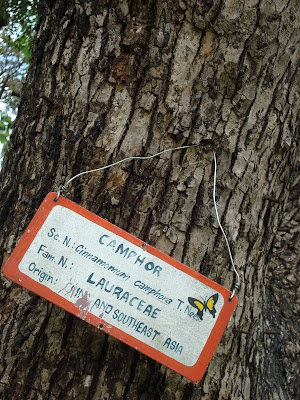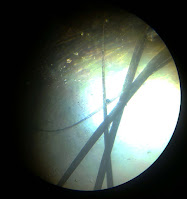Twilight in the Forest
"Twilight is the quiet awaiting of sleep and forgetting, the expectation of the sensation that is peaceful and resigned... The forest always silent, now assumes that calm that is more breathless and awesome than silence." - Dr Arturo B Rotor, Convict's Twilight
Light in the Woods in acrylic by Dr Abercio Valdez Rotor 1995, Displayed at the former St Paul University Museum QC. Cover of book Light in the Woods by the same author.
The forest, always silent, now assumes that calm that is more breathless and awesome than silence;
the breeze dies down, the leaves cease to rustle, the animals of the woods slink away to their lairs;
one sees only an occasional crow, its obstreperous caw-caw-cao echoing and re-echoing for miles around.
No Angelus rings here, for the nearest church is a day's journey away,
down the river and along the coast,
but one does not need to hear the tolling of distant bells to be reminded
of the hour for prayer.
One must pray here, if only to relieve the terrifying solitude,
to stay the gathering darkness.
Here one must kneel down, make the sign of the cross,
join the twilight hush that like a solemn invocation rises
above the heads of the tallest tree to heaven.
The darkness comes like a sluggish, ever deepening stream.
Imperceptibly it crawls, inch by inch, and as it crawls it swallows everything
that stands in its way,
first the towering trees, from their buttressed roots to the high quivering leaf,
then the shrubs and the undergrowth.
No one knows that it has reached a certain point by the sepulchral silence
that follows in its wake,
for it passes all sound and movement cease, the creaking of the stiff branches,
the scampering of the small animals under the trees,
even the wind as it hurries through the lattice of the leaves and vines seems arrested
in its flight.
Over the deep holes left by decaying logs, the deep puddles made by the wild boar,
this stream swirls and eddies and forms little unplumbed pools.
The hour signifies the end of the day's work, the cessation of all the hurrying
and stumbling during the day,
a chance to sit down or lie among the cool sedges that grow near the spring,
to bow your head or rest your bowed head on your arms;
twilight is the quiet awaiting of sleep and forgetting, the expectation
of the sensation that is peaceful and resigned...
The forest always silent, now assumes that calm that is more breathless
and awesome than silence.~
This piece was lifted from Convict's Twilight, by Dr Arturo B Rotor (PHOTO). The narrative beauty and musical language used by the author fit well with the style of a poem, although not so much with its new structure. But on reciting it, following the author's purposive punctuations to emphasize details of the scenarios in romantic mood, one can sense the nostalgia of the setting with the ambiance of twilight. (A V Rotor)
From the book, the Wound and the Scar, by Dr Arturo B Rotor, 1966 Republic Cultural Heritage Awardee for Literature. Dr Rotor finished medicine and conservatory of music at the same time from the University of the Philippines in 1932. He served as executive secretary of Presidents Quezon and Osmeña during the Second World War era.~



















































